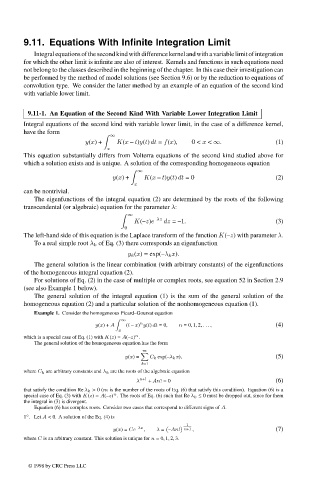Page 507 - Handbook Of Integral Equations
P. 507
9.11. Equations With Infinite Integration Limit
Integral equations of the second kind with difference kernel and with a variable limit of integration
for which the other limit is infinite are also of interest. Kernels and functions in such equations need
not belong to the classes described in the beginning of the chapter. In this case their investigation can
be performed by the method of model solutions (see Section 9.6) or by the reduction to equations of
convolution type. We consider the latter method by an example of an equation of the second kind
with variable lower limit.
9.11-1. An Equation of the Second Kind With Variable Lower Integration Limit
Integral equations of the second kind with variable lower limit, in the case of a difference kernel,
have the form
∞
y(x)+ K(x – t)y(t) dt = f(x), 0 < x < ∞. (1)
x
This equation substantially differs from Volterra equations of the second kind studied above for
which a solution exists and is unique. A solution of the corresponding homogeneous equation
∞
y(x)+ K(x – t)y(t) dt = 0 (2)
x
can be nontrivial.
The eigenfunctions of the integral equation (2) are determined by the roots of the following
transcendental (or algebraic) equation for the parameter λ:
∞
K(–z)e –λz dz = –1. (3)
0
The left-hand side of this equation is the Laplace transform of the function K(–z) with parameter λ.
To a real simple root λ k of Eq. (3) there corresponds an eigenfunction
y k (x) = exp(–λ k x).
The general solution is the linear combination (with arbitrary constants) of the eigenfunctions
of the homogeneous integral equation (2).
For solutions of Eq. (2) in the case of multiple or complex roots, see equation 52 in Section 2.9
(see also Example 1 below).
The general solution of the integral equation (1) is the sum of the general solution of the
homogeneous equation (2) and a particular solution of the nonhomogeneous equation (1).
Example 1. Consider the homogeneous Picard–Goursat equation
∞
n
y(x)+ A (t – x) y(t) dt =0, n =0, 1, 2, ... , (4)
x
n
which is a special case of Eq. (1) with K(z)= A(–z) .
The general solution of the homogeneous equation has the form
m
y(x)= C k exp(–λ k x), (5)
k=1
where C k are arbitrary constants and λ k are the roots of the algebraic equation
λ n+1 + An!=0 (6)
that satisfy the condition Re λ k >0 (m is the number of the roots of Eq. (6) that satisfy this condition). Equation (6) is a
n
special case of Eq. (3) with K(z)= A(–z) . The roots of Eq. (6) such that Re λ k ≤ 0 must be dropped out, since for them
the integral in (3) is divergent.
Equation (6) has complex roots. Consider two cases that correspond to different signs of A.
◦
1 . Let A < 0. A solution of the Eq. (4) is
1
y(x)= Ce –λx , λ = –An! n+1 , (7)
where C is an arbitrary constant. This solution is unique for n = 0,1,2,3.
© 1998 by CRC Press LLC
© 1998 by CRC Press LLC
Page 489

